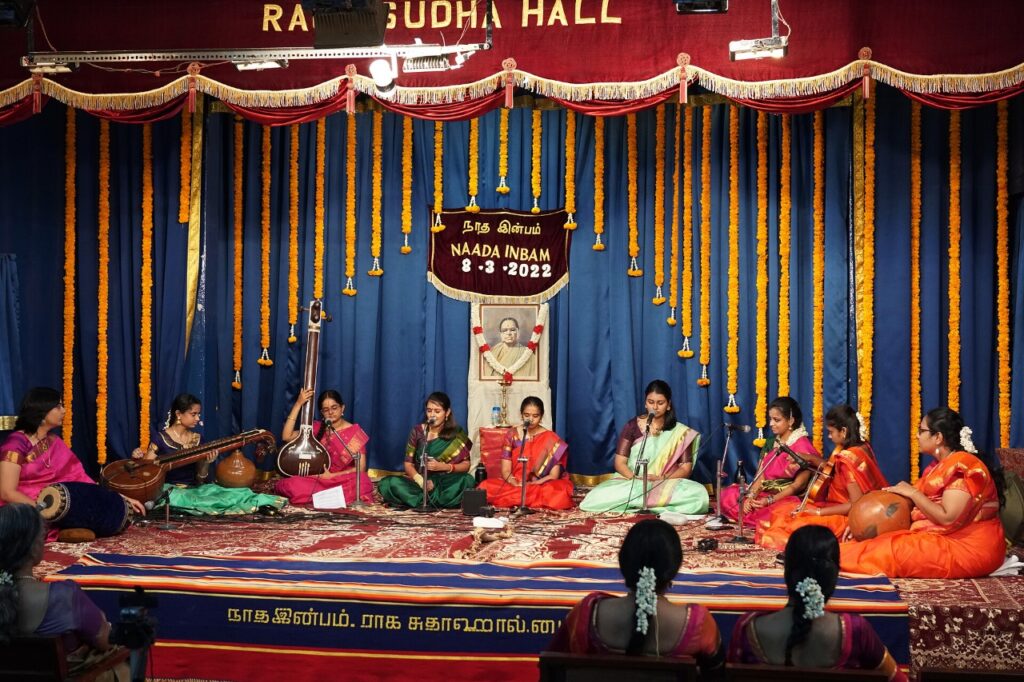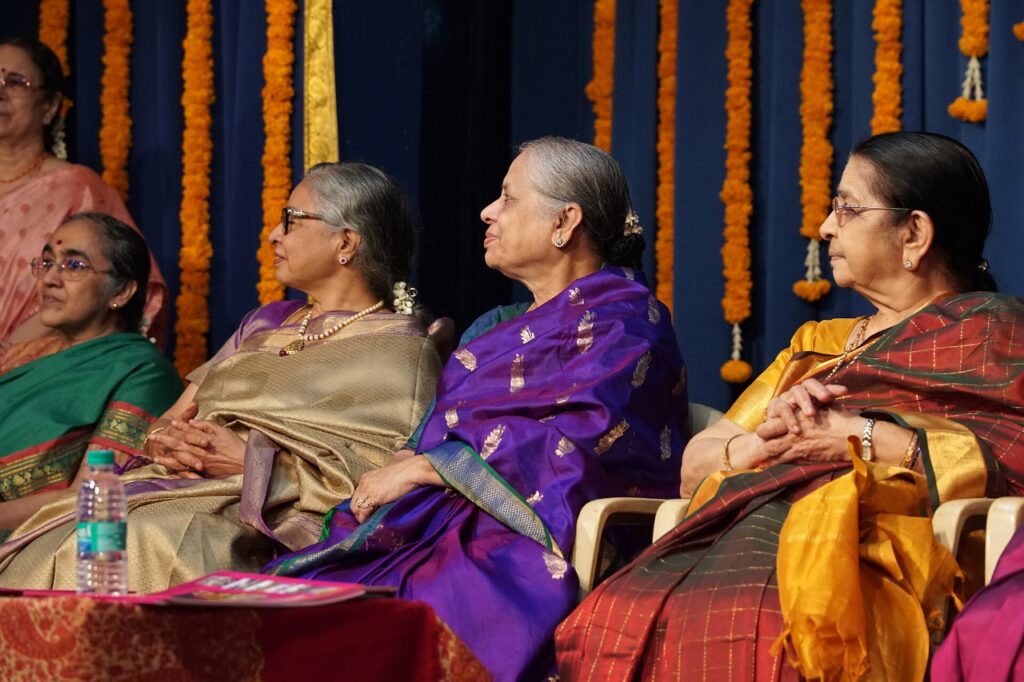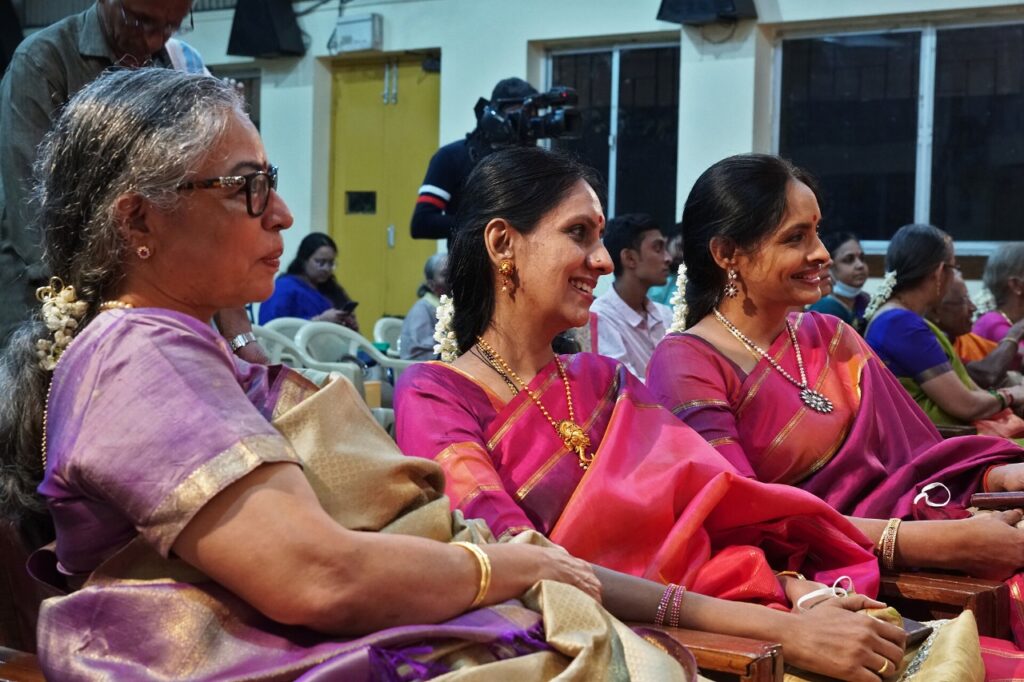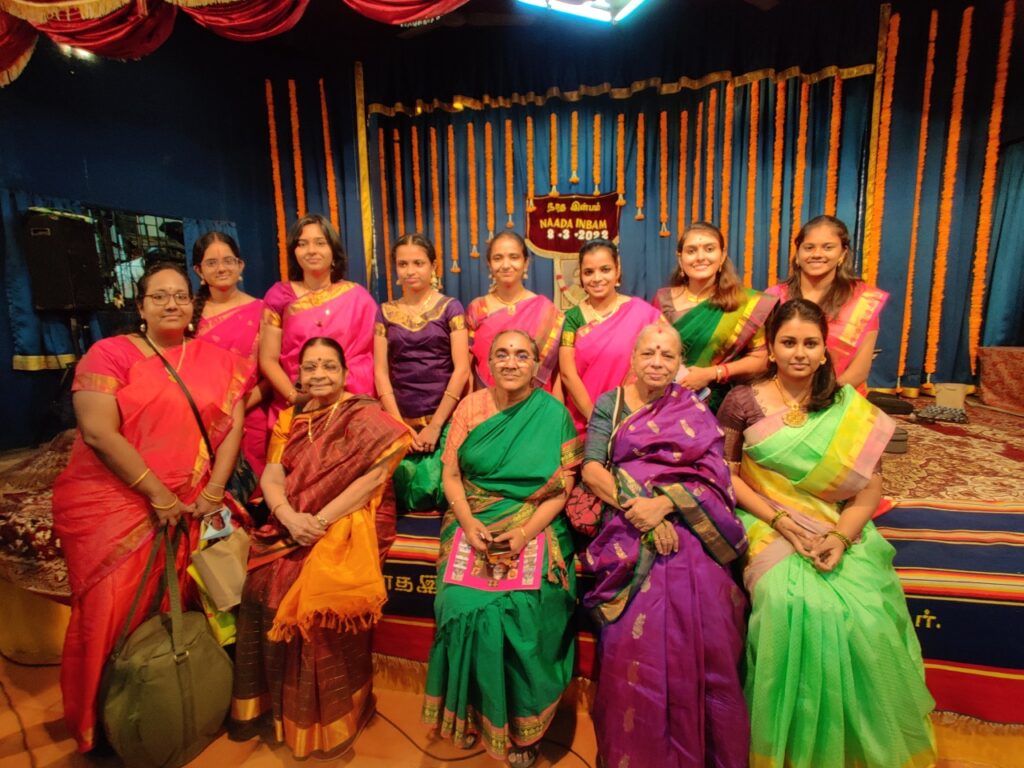Shakti in its very essence

Photo courtesy: Sri. Nick Haynes.
Though more women than men learn and teach music, they are heavily underrepresented in all other aspects such as composing, organising and producing. In fact, a 2017 report said that only 1.8 percent of the music programmed by major orchestras in the United States was written by women. These statistics transcend geography. In Carnatic music, while there have been female composers, few are commonly known or performed in the mainstream. All-female owned sabhas are a mere handful and female percussionists are few and far between the world over.
This article appeared in India Art Review dated March 14th, 2022. This was written as part of the Kalpalata Fellowship for Classical Music Writings for 2022.
In this context, Sundara Divya Ganam, a program organised on March 8th, International Women’s Day, was likely an unprecedented one. A nine-member all-women ensemble presented ten compositions of Late. Smt. Sundaravalli Ammal (1906-1981) tuned by veteran Carnatic vocalist Seetha Narayanan, instrumental interludes composed by Dr. R.S. Jayalakshmi and coordinated by Jayalakshmi Balakrishnan, the secretary of Naada Inbam. The chief guests were popular vocalists Ranjani and Gayatri and Dr. Meenakshi (Sumathi) Krishnan, Secretary of The Music Academy. For the book released on the occasion, the forewords were written by Suguna Varadachari, senior Carnatic vocalist and teacher and Prabha Sridevan, retired judge of the Madras High Court and author and translator.

Photo courtesy: Sri. Nick Haynes.
Sundaravalli Ammal was married at age 14. She was a housewife who moved, with her husband, between many cities and towns in the erstwhile Madras State. As was common then, she managed a large household with many family members. While not trained in music or literature, she would write a song about every temple she visited. In 1991, Sundaravalli’s daughter, botanist Dr. Andal Ananthanarayanan (1929-2013), published the first set of her mother’s works. Last year, her son, Dr. Amarnath Ananthanarayanan, had another set of compositions published, and also tuned (by K. Arun Prakash) and presented. Coming from a family of empowered women, Dr. Amarnath, himself a father of two teenaged girls, explains, “My mother too was a pathbreaker, doing a PhD in an era when it was unheard of for women. She even told my father that their marriage would have to wait until she completed her doctorate!”
The idea for Sundara Divya Ganam, the latest release, began with the family unearthing yet another set of Sundaravalli Ammal’s compositions. These were on the Divya Desams, 108 temples of especial significance in the Vaishnavite tradition. As Suguna Varadachari mentions, Sundaravalli Ammal’s lyrics, in simple, easily comprehensible Tamizh, describe key facets of each temple such as the names of the deity, the consort, the official vehicle and other details.
Dr. Amarnath saw an excellent opportunity to celebrate womanhood on Women’s Day with women cast in all roles. A long-time admirer of Sangita Kala Acharya Seetha Narayanan, she was his first choice for tunesmith. Seetha Narayanan is an A-Top graded vocalist from All India Radio Chennai whose Gurus include Kasi Viswanatha Bhagavathar, Nagercoil Harihara Iyer, P.K. Rajagopala Iyer, Dr. S. Ramanathan (from whom she learned veena as well) and Chingelput Ranganathan. She is also an excellent repository of bhajans in various languages that she learned in their authentic styles.
She carefully selected 10 compositions and appropriate pAsuram-s (devotional verses by the Azhwars – Tamizh Vaishnavite poet saints) for each temple too, tuning them as preludes for each composition. Besides being a link between old and new eras, she hoped that the pAsuram and the song together would present a complete picture of each temple. Rubrics for rAgam selection included ensuring that there was a mix between unambiguously Carnatic and Hindustani inspired rAgam-s, both heavy and light, and those that would fit together to provide for a satisfying live performance for the listener. She then taught the performers the tuned pieces over a few sessions on Zoom which they then worked on. Live rehearsals were conducted at Naada Inbam’s home of Raga Sudha Hall, overseen by Jayalakshmi.
Over the decades, Naada Inbam has exposed the listening public to many talented youngsters several of whom are today’s best and most sung. Jayalakshmi used her many years of experience to hand-pick a brigade of young promising performers ranging in age from 15-28. Ameya Karthikeyan (currently student at The Music Academy’s Advanced School for Carnatic Music), Madhuri Kaushik (student of Ranjani and Gayatri) and Svarathmika Sureshkumar (a student of Suguna Varadachari) on vocals, Haritha Narayanan (currently a student of Delhi P. Sunder Rajan) on violin, Charulatha Chandrasekhar (student and granddaughter of Dr. R.S. Jayalakshmi) on veena, Poornima Krishna Emani (currently a student of Dr. Niranjana Srinivasan) on flute, Aswini Srinivasan (student of T.K. Murthy) on mridangam and Ramya Ramesh (student of Sukanya Ramgopal) on ghatam. Maitreyi Vijay (student of R.K. Shriramkumar) rendered the prayer song, introduced each piece and played the tambura.
Speaking on the occasion, Gayatri, of the Ranjani Gayatri duo, said that while women have always been credited as nurturers, sustainers and loving presences, rarely do they get acknowledged for being at the forefront of economic, creative or intellectual activity. Seetha Narayanan was a pole star of inspiration, she said, and one who indulged in music with childlike enthusiasm without any expectations at all. She allowed every student to spread one’s own creative wings. Years ago, when the sisters had expressed a desire to learn bhajans from her, Seetha mami had shared many recordings with them and told them to sing it in their own way, added Gayatri.

Photo courtesy: Sri. Nick Haynes.
Dr. Meenakshi Krishnan stressed on the criticality of documentation for archival. After stating that tuning was no trivial task, she mentioned Subbarama Dikshitar, composer and author of the seminal Sangita Sampradaya Pradarshini, who, in the very early 1900s, had tuned Samskrta Andhra Dravida Kirtanulu – the compositions of a lawyer, Krishnaswamy Ayya of Ettayapuram. One of those pieces in common circulation, she mentioned, is Amba ParadEvate in Rudrapriya. Dr. Meenakshi went on to say that it was the singers who, by performing the compositions, brought them into circulation, adding polish and lustre to tuned pieces.
As Prabha Sridevan rightly noted, “Women did not lack creative genius – the social structures inhibited them.” She was referring to Sundaravalli Ammal’s times in the 20th century but, as recently as six months ago, when Marin Alsop finished her tenure at the Baltimore Symphony Orchestra, there were no more female directors in the USA’s Top 25 ensembles. In ‘conservative’ Chennai, by showcasing a female composer’s works tuned by a female tunesmith, performed by an entirely female ensemble and convened and presented by a female organiser, Sundara Divya Ganam shattered several glass ceilings in one go. One hopes this event serves as a harbinger of greater things to come from women, and the perception of women, not just in Chennai or India but all over the world.
For e-copies of the Sundara Divya Ganam book, please email aamar71@hotmail.com
The credit for the title of this article goes to Smt. Jayalakshmi Balakrishnan who mentioned it during a discussion.

Seated L-R: Smt. Seetha Narayanan, Smt. Jayalakshmi Balakrishnan, Dr. R.S. Jayalakshmi, Ameya Karthikeyan.
Photo courtesy: Sri. Prithvi via Smt. Ramya Ramesh
Related Articles: